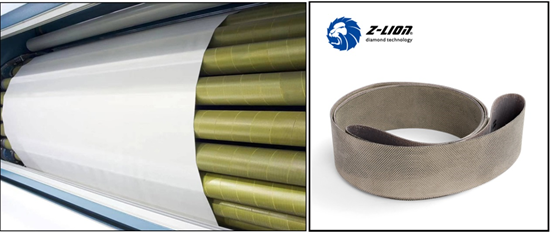Sueding or emerizing is a mechanical finishing process in which a fabric is abraded on one or both sides to raise or create a fibrous surface. This operation is often carried out before the raising process to reduce the friction between the fibres making up the cloth and consequently to facilitate the extraction of the fibre end.
The sueding or emerizing process is carried out on both sides of the fabric and modifies the appearance and the final hand of the cloth; when touched it gives a soft and smooth sensation similar to the one given by a peach grain surface.
The sueding machine is made up of some rotating rollers coated with abrasive paper or diamond strip, which emerise the cloth and produce a more or less marked effect depending upon the pressure exerted on the fabric by the abrasive or diamond rollers. The abrasive paper or diamond strip used can vary according to the desired sueding degree and must be replaced after a given number of operating hours, or when it does not properly carry out suitably the sueding function. In some cases, it is possible to use also metal rollers with the surface coated with uneven and rough grains or pumice rollers performing an excellent sueding action on both dry or wet fabrics. For a very superficial sueding, the natural abrasive power of pumice can be applied with successful results.
Gray fabrics as well as dyed ones can be subjected to the sueding or emerizing process; the cloth to be emerized must be completely free from any finishing resin or adhesive substance remaining on the fabric surface after desizing. The sueding or emerizing process reduces mechanic and dynamometric resistance of the fabric, thus making it more subject to tearing and seaming.
The fabric can run at different speeds inside the sueding unit; a smooth pressure is kept thanks to two balancing arms assembled at the entry and at the exit of the unit. The pieces of cloth must be sewn with abrasion-resistant material such as polyester or nylon. The gears must be suitably cleaned with compressed air jets since the presence of pile residues could clog the ball bearings or drop again on the fabric surface thus creating some problems with dyeing machines filters.
The sueding or emerizing process, which can affect the fabric with a very wide range of effects, can give some problem when applied to knitted tubular goods but it is widely used on woven fabrics with different weights and weaves (its application ranges from coarse jeans cloth to light and delicate silk or microfibre, coated fabrics and imitation leather).
The sueding unit is equipped with 6 rollers performing the sueding action on the face of the fabric and 1 roller performing its action of the back of the fabric; an advantage of this system is the possibility to use sueding cloths with different grains on each single roller. Thanks to three dandy rollers, the sueding action can be automatically adjusted during the fabric processing thus allowing the sueding process to be carried out also on knitted goods.
Post time: Apr-07-2022

